Magnetic Aspects and Large Exchange Bias of Ni0.9Co0.1/NiCoO Multilayers
Abstract
:1. Introduction
2. Materials and Methods
3. Results and Discussion
3.1. Multilayer Structural Characterization
3.2. Magnetic Characterization
4. Conclusions
Author Contributions
Funding
Institutional Review Board Statement
Informed Consent Statement
Data Availability Statement
Acknowledgments
Conflicts of Interest
References
- Heinrich, B.; Bland, J.A.C. Ultrathin Magnetic Structures I, 1st ed.; Springer: Berlin/Heidelberg, Germany, 1994; pp. 1–6. [Google Scholar]
- O’Handley, R.C. Modern Magnetic Materials: Principles and Applications, 1st ed.; Wiley: New York, NY, USA, 2000; pp. 676–720. [Google Scholar]
- Freitas, P.P.; Ferreira, R.; Cardoso, S. Spintronic Sensors. Proc. IEEE 2016, 104, 1894–1918. [Google Scholar] [CrossRef]
- Bhatti, S.; Sbiaa, R.; Hirohata, A.; Ohno, H.; Fukami, S.; Piramanayagam, S.N. Spintronics based random access memory: A review. Mater. Today 2017, 20, 530–548. [Google Scholar] [CrossRef]
- Felser, C.; Fecher, G.H.; Balke, B. Spintronics: A challenge for materials science and solid-state chemistry. Angew. Chem. 2007, 46, 668–699. [Google Scholar] [CrossRef]
- Schuller, I.K.; Kim, S.; Leighton, C. Magnetic superlattices and multilayers. J. Magn. Magn. Mater. 1999, 200, 571–582. [Google Scholar] [CrossRef]
- Nogués, J.; Sort, J.; Langlais, V.; Skumryev, V.; Suriñach, S.; Muñoz, J.S.; Baró, M.D. Exchange bias in nanostructures. Phys. Rep. 2005, 422, 65–117. [Google Scholar] [CrossRef]
- den Broeder, F.J.A.; Hoving, W.; Bloemen, P.J.H. Magnetic anisotropy of multilayers. J. Magn. Magn. Mater. 1991, 93, 562–570. [Google Scholar] [CrossRef]
- Dieny, B.; Speriosu, V.S.; Parkin, S.S.P.; Gurney, B.A.; Wilhoit, D.R.; Mauri, D. Giant magnetoresistance in soft ferromagnetic multilayers. Phys. Rev. B 1991, 43, 1297. [Google Scholar] [CrossRef] [PubMed]
- Moodera, J.S.; Kinder, L.R.; Wong, T.M.; Meservey, R. Large Magnetoresistance at Room Temperature in Ferromagnetic Thin Film Tunnel Junctions. Phys. Rev. Lett. 1995, 74, 3273–3276. [Google Scholar] [CrossRef] [PubMed]
- Bibes, M.; Villegas, J.E.; Barthélémy, A. Ultrathin oxide films and interfaces for electronics and spintronics. Adv. Phys. 2011, 60, 5–84. [Google Scholar] [CrossRef]
- Monso, S.; Rodmacq, B.; Auffret, S.; Casali, G.; Fettar, F.; Gilles, B.; Dieny, B.; Boyer, P. Crossover from in-plane to perpendicular anisotropy in Pt/CoFe/AlOx sandwiches as a function of Al oxidation: A very accurate control of the oxidation of tunnel barriers. Appl. Phys. Lett. 2002, 80, 4157–4159. [Google Scholar] [CrossRef]
- Nistor, L.E.; Rodmacq, B.; Auffret, S.; Dieny, B. Pt/Co/oxide and oxide/Co/Pt electrodes for perpendicular magnetic tunnel junctions. Appl. Phys. Lett. 2009, 94, 012512. [Google Scholar] [CrossRef]
- Manchon, A.; Ducruet, C.; Lombard, L.; Auffret, S.; Rodmacq, B.; Dieny, B.; Pizzini, S.; Vogel, J.; Uhlíř, V.; Hochstrasser, M.; et al. Analysis of oxygen induced anisotropy crossover in Pt/Co/M Ox trilayers. J. App. Phys. 2008, 104, 043914. [Google Scholar] [CrossRef] [Green Version]
- Gao, H.; Harumoto, T.; Luo, W.; Lan, R.; Feng, H.; Du, Y.; Nakamura, Y.; Shi, J. Room temperature perpendicular exchange bias in CoNi/(Co,Ni)O multilayers with perpendicular magnetic anisotropy directly induced by FM/AFM interface. J. Magn. Magn. Mater. 2019, 473, 490–494. [Google Scholar] [CrossRef]
- Dieny, B.; Chshiev, M. Perpendicular magnetic anisotropy at transition metal/oxide interfaces and applications. Rev. Mod. Phys. 2017, 89, 025008. [Google Scholar] [CrossRef]
- Fukami, S.; Sato, H.; Yamanouchi, M.; Ikeda, S.; Ohno, H. CoNi Films with Perpendicular Magnetic Anisotropy Prepared by Alternate Monoatomic Layer Deposition. Appl. Phys. Express 2013, 6, 073010. [Google Scholar] [CrossRef]
- Pan, Y.; Zhou, Y.; Zhou, Y.; Huang, Y.; Liao, Y.; Sun, S. Fabrication, lattice strain, corrosion resistance and mechanical strength of nanocrystalline nickel films. Trans. Nonferrous Met. Soc. China 2007, 17, 1225–1229. [Google Scholar] [CrossRef]
- Gomez, E.; Pane, S.; Valles, E. Electrodeposition of Co–Ni and Co–Ni–Cu systems in sulphate–citrate medium. Electrochim. Acta 2005, 51, 146–153. [Google Scholar] [CrossRef]
- Lin, K.-W.; Guo, J.-Y.; Liu, H.-Y.; Ouyang, H.; Chan, Y.-L.; Wei, D.-H.; Van Lierop, J. Anomalous exchange bias behavior in ion-beam bombarded NiCo/ (Ni,Co)O bilayers. J. Appl. Phys. 2008, 103, 07C105. [Google Scholar] [CrossRef]
- Meiklejohn, W.H.; Bean, C.P. New Magnetic Anisotropy. Phys. Rev. 1956, 102, 1413. [Google Scholar] [CrossRef]
- Altuncevahir, B.; Koymen, A.R. Positive and negative exchange bias in CoNi/Gd/CoNi trilayers and CoNi/Gd bilayers. J. Magn. Magn. Mater. 2003, 261, 424–432. [Google Scholar] [CrossRef]
- Nogues, J.; Schuller, I.K. Exchange bias. J. Magn. Magn. Mater. 1999, 192, 203–232. [Google Scholar] [CrossRef]
- Spadaro, M.C.; D’Addato, S.; Luches, P.; Valeri, S.; Grillo, V.; Rotunno, E.; Roldan, M.A.; Pennycook, S.J.; Ferretti, A.M.; Capetti, E.; et al. Tunability of exchange bias in Ni≅NiO coreshell nanoparticles obtained by sequential layer deposition. Nanotechnology 2015, 26, 405704. [Google Scholar] [CrossRef]
- Poulopoulos, P.; Kapaklis, V.; Jönsson, P.E.; Papaioannou, E.Th.; Delimitis, A.; Pappas, S.D.; Trachylis, D.; Politis, C. Positive surface and perpendicular magnetic anisotropy in natural nanomorphous Ni/NiO multilayers. Appl. Phys. Lett. 2010, 96, 202503. [Google Scholar] [CrossRef]
- Poulopoulos, P.; Pappas, S.D.; Kapaklis, V.; Jönsson, P.E.; Papaioannou, E.T.; Delimitis, A.; Trachylis, D.; Velgakis, M.J.; Meletis, E.I.; Politis, C. Growth and Magnetism of Natural Multilayers. J. Nano Res. 2011, 15, 95–103. [Google Scholar] [CrossRef]
- Pappas, S.D.; Kapaklis, V.; Delimitis, A.; Jönsson, P.E.; Papaioannou, E.Th.; Poulopoulos, P.; Fumagalli, P.; Trachylis, D.; Velgakis, M.J.; Politis, C. Layering and temperature-dependent magnetization and anisotropy of naturally produced Ni/NiO multilayers. J. Appl. Phys. 2012, 112, 053918. [Google Scholar] [CrossRef] [Green Version]
- Pappas, S.D.; Delimitis, A.; Kapaklis, V.; Papaioannou, E.T.; Poulopoulos, P.; Trachylis, D.; Velgakis, M.J.; Politis, C. Natural Nanomorphous Ni/NiO Magnetic Multilayers: Structure and Magnetism of the High-Ar Pressure Series. J. Nano Nanotech. 2014, 14, 6103–6107. [Google Scholar] [CrossRef]
- Santarossa, F.; Pappas, S.D.; Delimitis, A.; Sousanis, A.; Poulopoulos, P. Naturally Produced Co/CoO Nanocrystalline Magnetic Multilayers: Structure and Inverted Hysteresis. J. Nanosci. Nanotechnol. 2016, 16, 4960–4967. [Google Scholar] [CrossRef] [PubMed]
- Anyfantis, D.I.; Sarigiannidou, E.; Rapenne, L.; Stamatelatos, A.; Ntemogiannis, D.; Kapaklis, V.; Poulopoulos, P. Unexpected Development of Perpendicular Magnetic Anisotropy in Ni/NiO Multilayers after Mild Thermal Annealing. IEEE Magn. Lett. 2019, 10, 1–5. [Google Scholar] [CrossRef]
- Anyfantis, D.I.; Kanistras, N.; Barnasas, A.; Poulopoulos, P.; Papaioannou, E.Th.; Conca, A.; Trachylis, D.; Politis, C. Effects of Thermal Annealing and Ni Addition on the Magnetic Properties of Co–CoO Multilayers. SPIN 2020, 40, 2050030. [Google Scholar] [CrossRef]
- Flevaris, N.K.; Krishnan, R. Modulation-induced effects in magnetic multilayers: Perpendicular anisotropy, reversed hysteresis and magnetization enhancement. J. Magn. Magn. Mater. 1992, 104–107, 1760–1762. [Google Scholar] [CrossRef]
- Sousanis, A.; Grammatikopoulos, S.; Delimitis, A.; Dracopoulos, V.; Poulopoulos, P. Localized surface plasmon resonances after selective oxidization of AuCu solid solution nanocrystalline films. Appl. Phys. Lett. 2015, 107, 011903. [Google Scholar] [CrossRef]
- Karoutsos, V. Scanning Probe Microscopy: Instrumentation and Applications on Thin Films and Magnetic Multilayers. J. Nanosci. Nanotechnol. 2009, 9, 6783–6798. [Google Scholar] [CrossRef]
- Kapaklis, V.; Pappas, S.D.; Poulopoulos, P.; Trachylis, D.; Schweiss, P.; Polotis, C. Structure and magnetic properties of hcp and fcc nanocrystalline thin Ni films and nanoparticles produced by radio frequency magnetron sputtering. J. Nanosci. Nanotechnol. 2010, 10, 6024–6028. [Google Scholar] [CrossRef] [PubMed]
- Pearson, W.B.; Thompson, L.T. The Lattice Spacings of Nickel Solid Solutions. Can. J. Phys. 1957, 35, 349. [Google Scholar] [CrossRef]
- Björck, M.; Andersson, G. GenX: An extensible X-ray reflectivity refinement program utilizing differential evolution. J. Appl. Crystall. 2007, 40, 1174–1178. [Google Scholar] [CrossRef]
- Kiessig, H. Untersuchungen zur Totalreflexion von Röntgenstrahlen. Ann. Phys. 1931, 402, 715–768. [Google Scholar] [CrossRef]
- Poulopoulos, P.; Baberschke, K. Magnetism in thin films. J. Phys. Cond. Matt. 1999, 11, 9495–9515. [Google Scholar] [CrossRef]
- Blachowicz, T.; Ehrmann, A. Exchange Bias in Thin Films—An Update. Coatings 2021, 11, 122. [Google Scholar] [CrossRef]
- McCord, J.; Mangin, S. Separation of low- and high-temperature contributions to the exchange bias in Ni81Fe19-NiO thin films. Phys. Rev. B 2013, 88, 014416. [Google Scholar] [CrossRef]
- Martien, D.; Takano, K.; Berkowitz, A.E.; Smith, D.J. Increasing the exchange-bias field of Ni 0.5 Co 0.5 O films by microstructural control. Appl. Phys. Lett. 1999, 74, 1314. [Google Scholar] [CrossRef]
- Domann, J.P.; Sun, W.Y.; Schelhas, L.T.; Carman, G.P. Strain-mediated multiferroic control of spontaneous exchange bias in Ni-NiO heterostructures. J. Appl. Phys. 2016, 120, 143904. [Google Scholar] [CrossRef]
- Geshev, J.; Pereira, L.G.; Skumryev, V. Comment on “Exchange Bias Dependence on Interface Spin Alignment in a Ni80Fe20/(Ni Fe)O Thin Film”. Phys. Rev. Lett. 2008, 100, 039701. [Google Scholar] [CrossRef] [Green Version]
- Pebley, A.C.; Fuks, P.E.; Pollock, T.M.; Gordon, M.J. Exchange bias and spin glass behavior in biphasic NiFe2O4/NiO thin films. J. Magn. Magn. Mater. 2016, 419, 29–36. [Google Scholar] [CrossRef] [Green Version]
- Fraune, M.; Rudiger, U.; Guntherodt, G.; Cardoso, S.; Freitas, P. Size dependence of the exchange bias field in NiO/Ni nanostructure. Appl. Phys. Lett. 2000, 77, 3815–3817. [Google Scholar] [CrossRef] [Green Version]
- Schlenker, C.; Parkin, S.S.P.; Scott, J.C.; Howard, K. Magnetic Disorder in the Exchange Bias Bilayered FeNi-FeMn System. J. Magn. Magn. Mater. 1986, 54–57, 801–802. [Google Scholar] [CrossRef]
- Liu, K.; Ma, S.C.; Zhang, Z.S.; Zhao, X.W.; Yang, B.; Wang, D.H.; Ur Rehman, S.; Zhong, Z.C. Giant exchange bias effect in all-3d-metal Ni38.8Co2.9Mn37.9Ti20.4 thin film. Appl. Phys. Lett. 2020, 116, 022412. [Google Scholar] [CrossRef]
- Barman, R.; Singh, S.K.; Kaur, D. Enhanced exchange bias in magnetron-sputtered Ni–Mn–Sb–Al ferromagnetic shape memory alloy thin films. Curr. Appl. Phys. 2014, 14, 1755–1759. [Google Scholar] [CrossRef]
- Vishnoi, R.; Kaur, D. Exchange bias behaviour in magnetron sputtered Ni49.8Mn36.1Sn13.9 ferromagnetic shape memory alloy thin film. J. Alloys Comp. 2011, 509, 2833–2837. [Google Scholar] [CrossRef]
- Ambrose, T.; Chien, C.L. Finite-size scaling in thin antiferromagnetic CoO layers. J. Appl. Phys. 1996, 79, 5920. [Google Scholar] [CrossRef]
- Gladii, O.; Frangou, L.; Forestier, G.; Seeger, R.L.; Auffret, S.; Rubio-Roy, M.; Weil, R.; Mougin, A.; Gomez, C.; Jahjah, W.; et al. Spin pumping as a generic probe for linear spin fluctuations: Demonstration with ferromagnetic and antiferromagnetic orders, metallic and insulating electrical states. Appl. Phys. Expr. 2019, 12, 023001. [Google Scholar] [CrossRef] [Green Version]
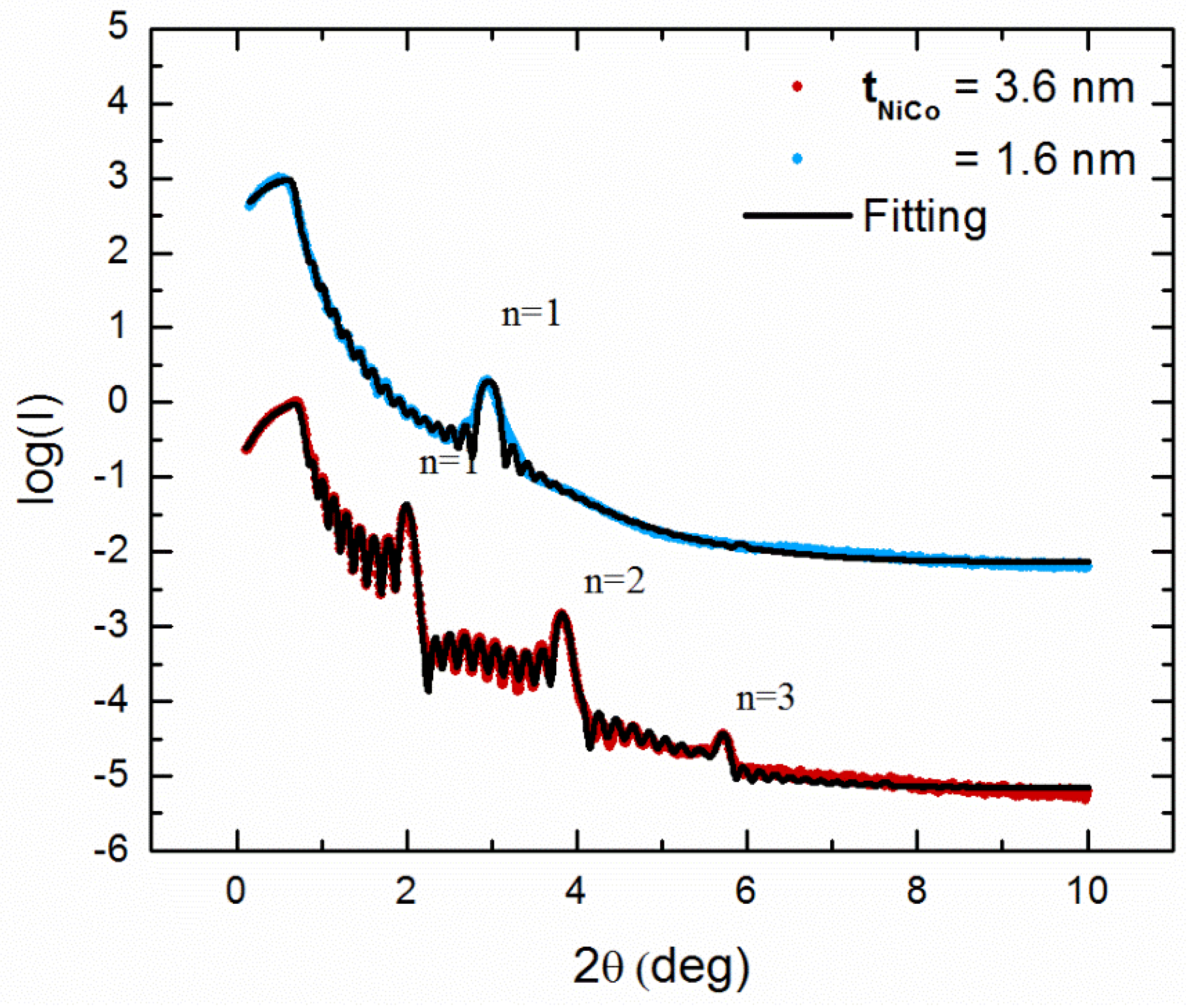

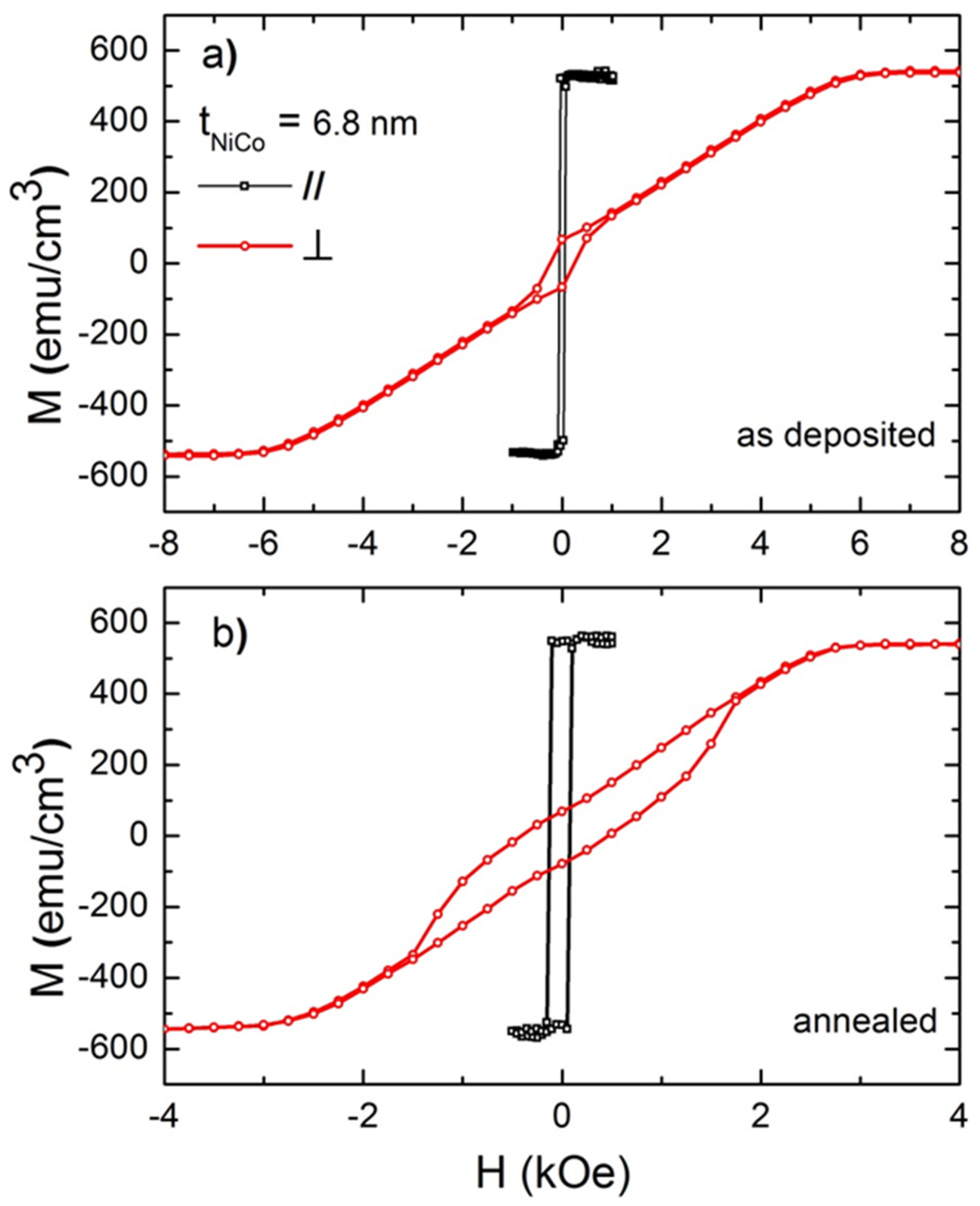
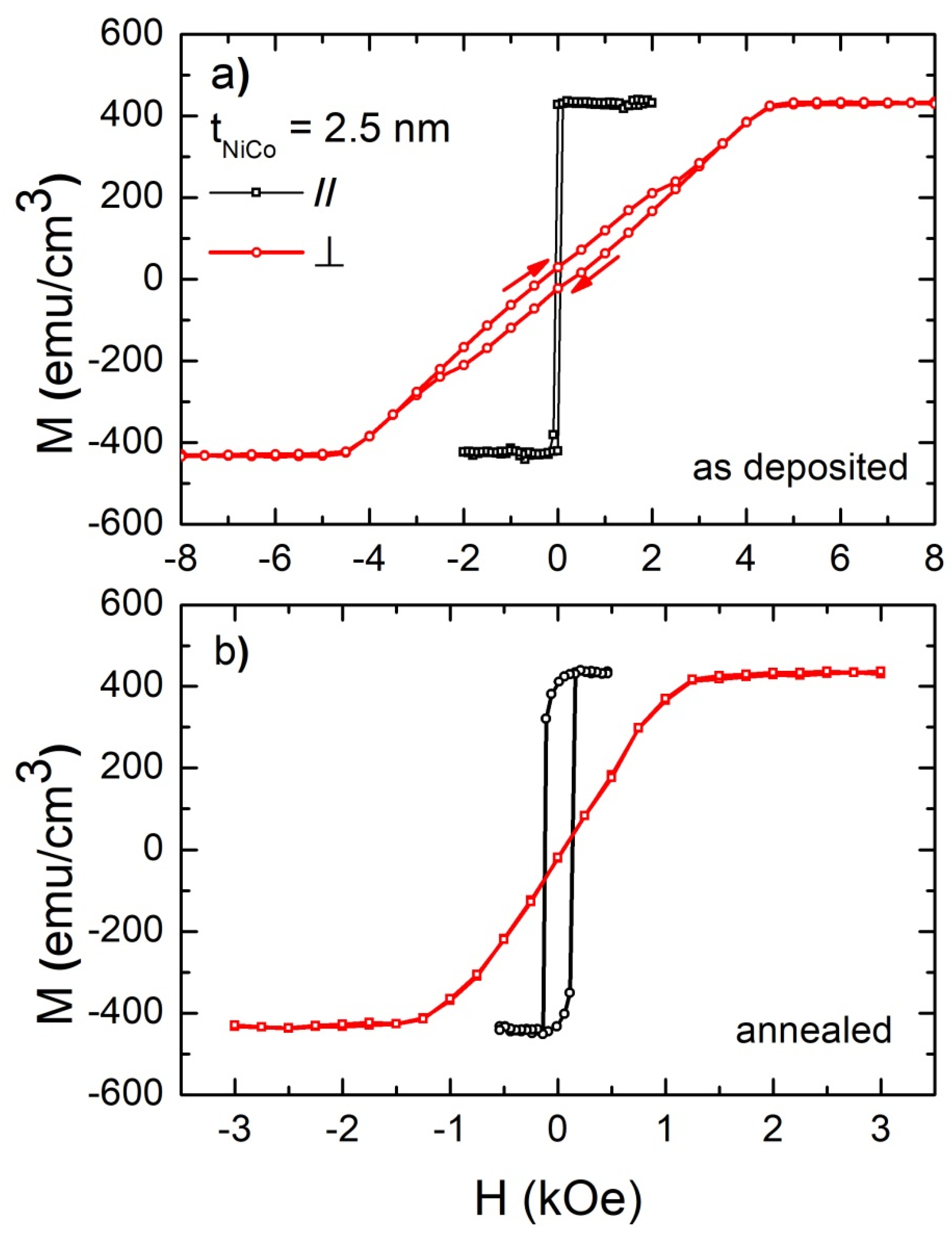

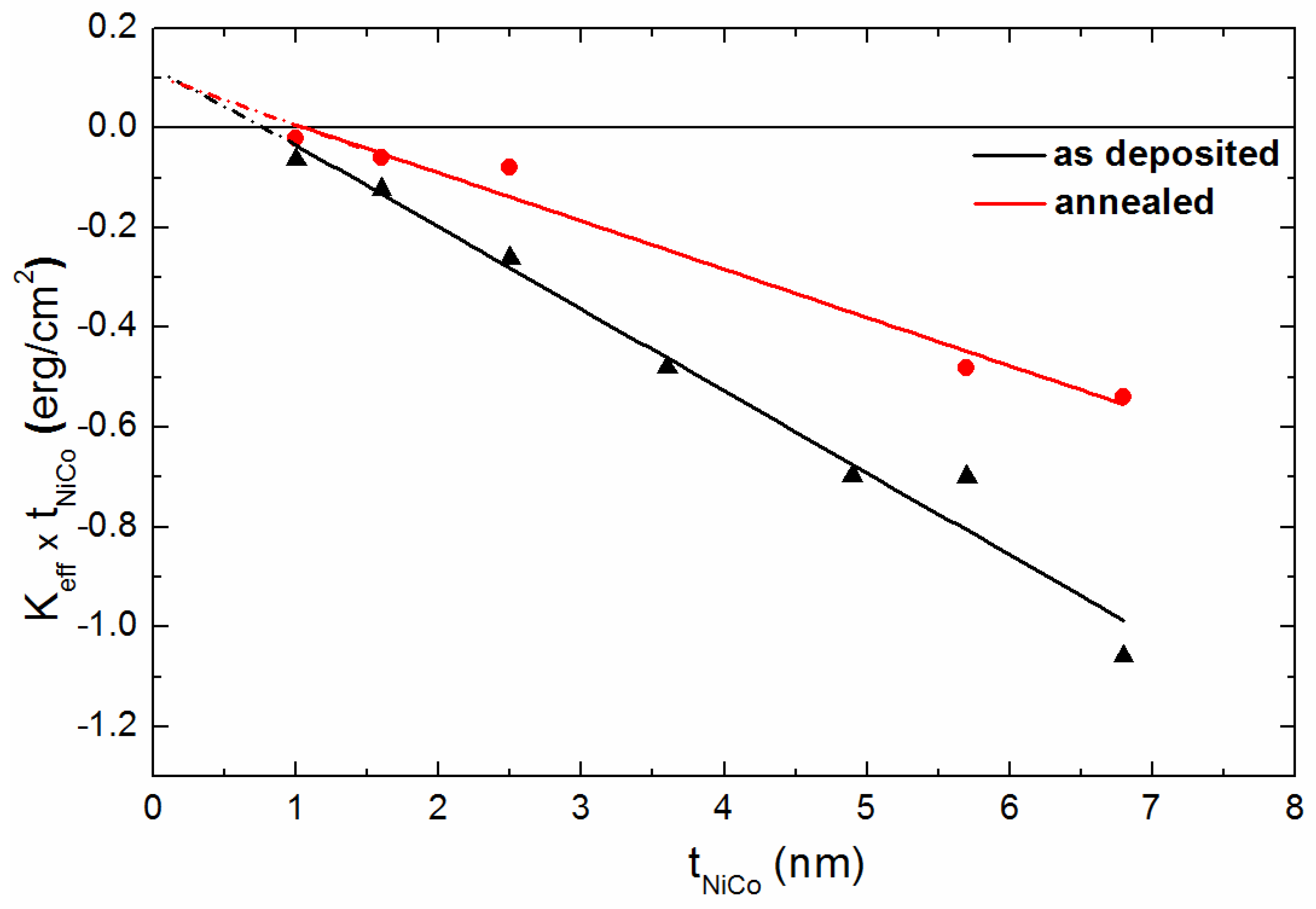
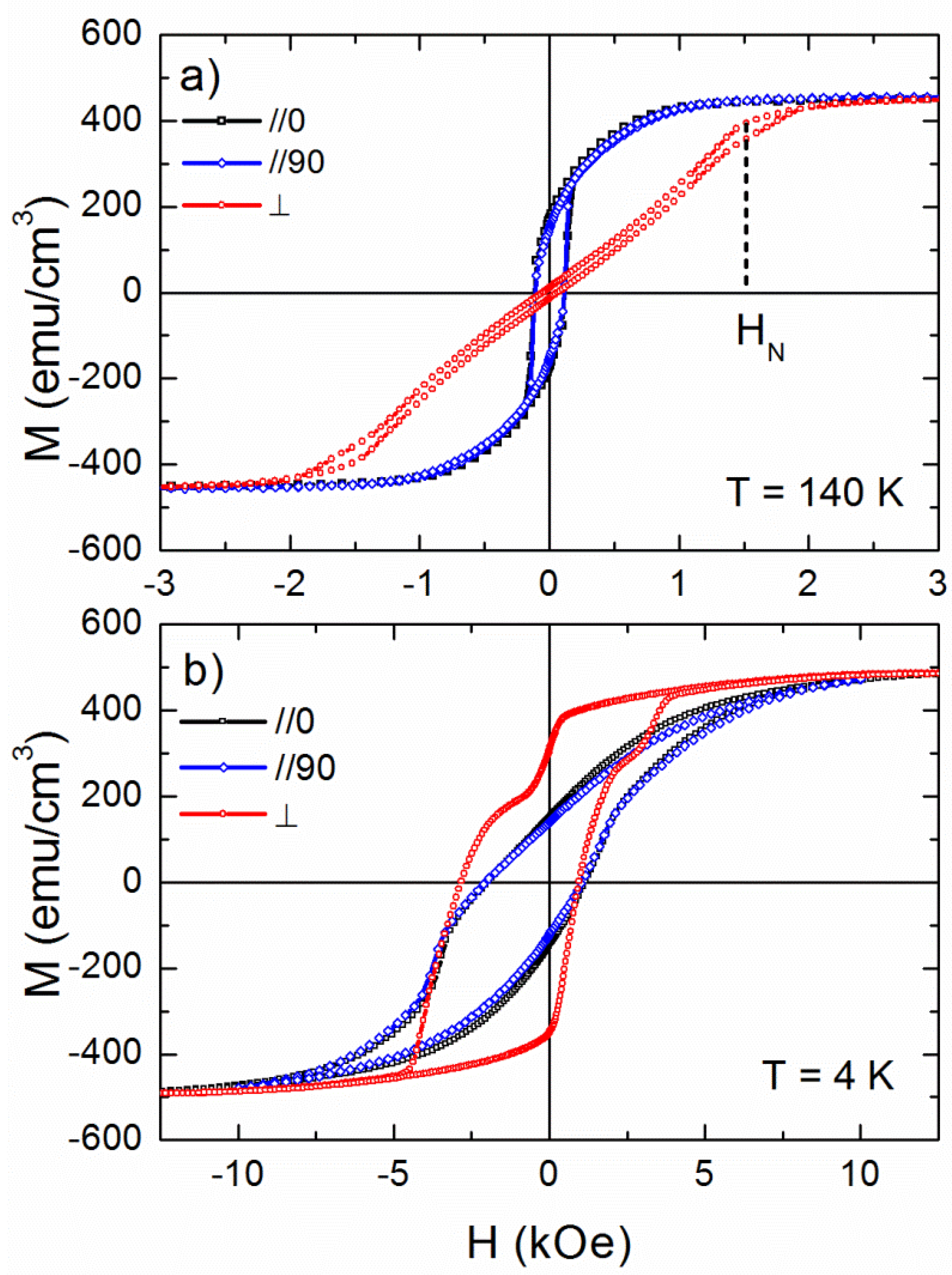


| Material | HE (Oe) | HC Enhancement | Reference |
|---|---|---|---|
| NiFe2O4/NiO | 2000 | - | [45] |
| Ni38.8Co2.9Mn37.9Ti20.4 | 1200 | No | [48] |
| NiCo/NiCoO | 744 | Yes | This work |
| Ni50Mn36.3Sb10.4Al3.3 | 611 | Yes | [49] |
| Ni/NiO | 570 | No | [24] |
| NiO/Ni | 258 | Yes | [46] |
| Ni81Fe19/NiO | 110 | Yes | [41] |
| NiCoO/NiFe | 85 | - | [42] |
| Ni49.8Mn36.1Sn13.9 | 41 | No | [50] |
| Ni/NiO | 40 | Yes | [43] |
| NiFe/NiFeO | 38 | - | [44] |
| FeNi/FeMn | 26 | - | [47] |
Publisher’s Note: MDPI stays neutral with regard to jurisdictional claims in published maps and institutional affiliations. |
© 2021 by the authors. Licensee MDPI, Basel, Switzerland. This article is an open access article distributed under the terms and conditions of the Creative Commons Attribution (CC BY) license (https://creativecommons.org/licenses/by/4.0/).
Share and Cite
Anyfantis, D.I.; Kanistras, N.; Ballani, C.; Barnasas, A.; Kapaklis, V.; Schmidt, G.; Papaioannou, E.T.; Poulopoulos, P. Magnetic Aspects and Large Exchange Bias of Ni0.9Co0.1/NiCoO Multilayers. Micro 2021, 1, 43-54. https://0-doi-org.brum.beds.ac.uk/10.3390/micro1010005
Anyfantis DI, Kanistras N, Ballani C, Barnasas A, Kapaklis V, Schmidt G, Papaioannou ET, Poulopoulos P. Magnetic Aspects and Large Exchange Bias of Ni0.9Co0.1/NiCoO Multilayers. Micro. 2021; 1(1):43-54. https://0-doi-org.brum.beds.ac.uk/10.3390/micro1010005
Chicago/Turabian StyleAnyfantis, Dimitrios I., Nikos Kanistras, Camillo Ballani, Alexandros Barnasas, Vassilios Kapaklis, Georg Schmidt, Evangelos Th. Papaioannou, and Panagiotis Poulopoulos. 2021. "Magnetic Aspects and Large Exchange Bias of Ni0.9Co0.1/NiCoO Multilayers" Micro 1, no. 1: 43-54. https://0-doi-org.brum.beds.ac.uk/10.3390/micro1010005







